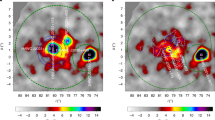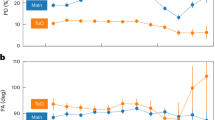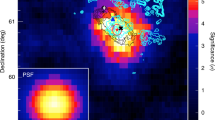Abstract
Ultrahigh-energy γ rays (≳ 1015eV) have recently been observed from the binary X-ray sources Cygnus X-3 and Vela X-1. The source of these γ rays remains unknown but it seems likely that protons or nuclei are accelerated, the γ rays resulting from nuclear interactions with matter or radiation. Objects of this type could then contribute significantly to the observed cosmic radiation. The maximum proton energy that can be achieved (this may determine the maximum γ-ray energy) occurs when the acceleration time scale becomes greater than the energy loss time scale, that is, the attenuation time. Here we have calculated the attenuation times of protons and heavier nuclei in the radiation fields of the stellar companions to the Cyg X-3 and Vela X-1 compact objects. The maximum observed γ-ray energy enables us to put an upper limit on the acceleration time scale of protons at 3×1016 eV of 104−3 × 105 s for Cyg X-3 and 105 s for Vela X-1. This result can be used to put some constraints on the nature of the particle accelerator. If binary X-ray sources are contributing significantly to the cosmic rays, the cosmic-ray abundances will be affected by photonuclear interactions.
This is a preview of subscription content, access via your institution
Access options
Subscribe to this journal
Receive 51 print issues and online access
$199.00 per year
only $3.90 per issue
Buy this article
- Purchase on SpringerLink
- Instant access to full article PDF
Prices may be subject to local taxes which are calculated during checkout
Similar content being viewed by others
References
Samorski, M. & Stamm, W. Astrophys. J. Lett. 268, L17–L21 (1983).
Lloyd-Evans, J. et al. Nature 305, 784–787 (1983).
Protheroe, R. J., Clay, R. W. & Gerhardy, P. R. Astrophys. J. Lett. 280, L47–L50 (1984).
Eichler, D. & Vestrand, W. T. Nature 307, 613–614 (1984).
Wdowczyk, J. & Wolfendale, A. W. Nature 305, 609–610 (1983).
Ormes, J. F. & Protheroe, R. J. Astrophys. J. 272, 756–764 (1983).
Armstrong, T. A. et al. Phys. Rev. D5, 1640–1652 (1972).
Stecker, F. W. Phys. Rev. Lett. 21, 1016–1018 (1968).
Blumenthal, G. R. Phys. Rev. D1, 1596–1602 (1970).
Puget, J. L., Stecker, F. W. & Bredekamp, J. H. Astrophys. J. 205, 638–654 (1976).
Bradt, H. V. D. & McClintock, J. E. A. Rev. Astr. Astrophys. 21, 13–66 (1983).
Rappaport, S. & Joss, P. in X-ray Astronomy with the Einstein Satellite (ed. Giacconi, R.) 123 (Reidel, Dordrecht 1981).
Dupree, A. K. et al. Astrophys. J. 238, 969–981 (1980).
Protheroe, R. J. Astrophys. J. 251, 387–392 (1981).
Webber, W. R. & Brautigam, D. A. Astrophys. J. 260, 894–908 (1982).
Ghosh, P., Elsner, R. F., Weisskopf, M. C. & Sutherland, P. G. Astrophys. J. 251, 230–245 (1981).
van den Heuvel, E. P. J. & de Loore, C. Astr. Astrophys. 25, 387–395 (1973).
Mason, K. O. et al. Astrophys. J. 207, 78–87 (1976).
Vestrand, W. T. & Eichler, D. Astrophys. J. 261, 251–258 (1982).
Stephens, S. A. & Verma, R. P. Nature 308, 808–830 (1984).
Protheroe, R. J. J. Phys G 10, L99–L106 (1984).
Paczynski, B. Acta astr. 21, 1–14 (1971).
Author information
Authors and Affiliations
Rights and permissions
About this article
Cite this article
Protheroe, R. Clues from the photonuclear time scale on the nature of particle accelerators in Cygnus X-3 and Vela X-1. Nature 310, 296–298 (1984). https://doi.org/10.1038/310296a0
Received:
Accepted:
Issue date:
DOI: https://doi.org/10.1038/310296a0
This article is cited by
-
Origin of ultra-high-energy γ-rays from Cygnus X-3 and related sources
Nature (1986)
-
First observation of ultra-high-energy γ rays from LMC X-4
Nature (1985)
-
Galactic high-energy astrophysics after the gamma-ray astronomy mission of the ESΛ COS-B satellite
La Rivista Del Nuovo Cimento Series 3 (1984)



